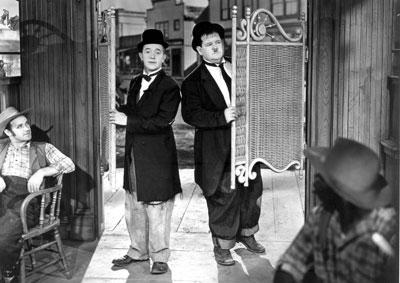Directed by James W. Horne
When asked what film made with partner Oliver Hardy was his favorite, Stan Laurel most often cited Way Out West. The Boys' only joint venture into the Old West, the film ranks at or near the top of great Laurel and Hardy films. Comedian Dick Van Dyke, a close friend of Stan Laurel, puts it at the top of his list, as do film historians William K. Everson and Leonard Maltin. Contemporary reviewers also held Way Out West in high regard—"Box Office" called it "a hilarious comedy, probably the best the team has made."
The story has Stan and Ollie traveling to Brushwood Gulch to deliver the deed of a gold mine to the daughter of their recently deceased friend. But in an attempt to obtain instant fortune for themselves, the girl's employers—a shady saloon owner and his dance-hall girlfriend—scheme to hide her true identity from the Boys.
All the typical Laurel and Hardy routines are present, plus the Boys also do a couple of very endearing musical numbers. Outside of the saloon, Stan and Ollie perform a soft shoe dance routine while the Avalon Boys sing "At the Ball." Inside the saloon, the two sing "On the Trail of the Lonesome Pine," a nice number that highlights the truly fine musical voice of Oliver Hardy. Stan sings too, but the big laugh at the end comes when first the deep bass voice of Chill Wills (character actor and vocalist for the Avalon Boys) and then the high falsetto of Rosina Lawrence are dubbed in for Stan's usual English music-hall vocals. Musical director Marvin T. Hatley received an Oscar nomination for the score.
–Rob Stone
Hal Roach Studios, Inc./ Metro-Goldwyn-Mayer Producer: Hal Roach Screenwriters: Charles Rogers, Felix Adler, James Parrott Cinematographers: Art Lloyd, Walter Lundin Editor: Bert Jordan Cast: Stan Laurel, Oliver Hardy, Sharon Lynne, James Finalyson, Rosina Lawrence, The Avalon Boys
35mm, 64 min.
Preserved from a 35mm nitrate positive print and a studio work print. Laboratory services by The Stanford Theatre Film Laboratory, Audio Mechanics, OJ Audio. Special thanks to: Richard W. Bann. RHI Entertainment, and LLC.






 Mobile Navigation
Mobile Navigation

